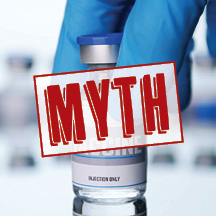 August is Immunization Awareness Month. This year, Door County Medical Center is highlighting the importance of vaccines not just to our physical health, but also to the general wellbeing of society and even economic growth. More importantly, as many Americans get sick each year from diseases that vaccines can prevent, DCMC is taking this moment to remind you to check in with your Primary Care Provider—to make sure that your vaccinations, and the vaccinations of your children, are up to date.
August is Immunization Awareness Month. This year, Door County Medical Center is highlighting the importance of vaccines not just to our physical health, but also to the general wellbeing of society and even economic growth. More importantly, as many Americans get sick each year from diseases that vaccines can prevent, DCMC is taking this moment to remind you to check in with your Primary Care Provider—to make sure that your vaccinations, and the vaccinations of your children, are up to date.
•
What exactly is a vaccine?
The Centers for Disease Control and Prevention (CDC) explains vaccines and how they work by defining four different terms:
-
Immunity: "Protection from an infectious disease." If your body's immune system is able to recognize an infection—primarily bacterial, viral or fungal—and neutralize it before you become sick, then you are immune to the disease and can be exposed to it without becoming infected.
-
Vaccine: "A product that stimulates a person's immune system to produce immunity to a specific disease, protecting the person from that disease." Vaccines stimulate the immune system by introducing molecules from the pathogen—called antigens—into your body, thereby allowing your immune system to recognize the pathogen. The next time you are exposed to that pathogen, the immune system will be able to recognize it and neutralize it before you get sick.
-
Vaccination: "The act of introducing a vaccine into the body to produce immunity to a specific disease." This is generally performed with a needle injection, but some vaccines can also be administered orally or with a nasal spray.
-
Immunization: "A process by which a person becomes protected against disease through vaccination. The term is often used interchangeably with vaccination or inoculation.
The history of vaccination—it's older than you think!
Smallpox was one of the deadliest diseases known to human history. First known outbreaks trace back at least as far as Egypt around 1350 BCE, with evidence of smallpox infection being discovered on mummies from that era.
Over the centuries, smallpox killed hundreds of millions of people. It was a horrific disease, characterized by high fever, vomiting and mouth sores, followed by fluid-filled lesions on the whole body, and it spared no one—rich or poor, young or old—often killing more than 1 in 3 who were infected. Those who did survive were often left blind or infertile. It may not be surprising then that the history of vaccination begins with people looking to prevent smallpox.
Early on, efforts to inoculate against smallpox—called variolation (smallpox was known as variola at the time)—consisted of the deliberate transfer of smallpox material to healthy individuals, resulting in milder illness and lower mortality compared to natural infection. The practice of variolation can be traced back nearly 500 years to Asia and the Ottoman Empire, reaching Europe in the early 18th century.2
The first modern vaccine against smallpox appeared in England in 1796, when Dr. Edward Jenner began inoculating people against smallpox by using matter from a cowpox sore (the word vaccine comes from the Latin for cow—vacca). Over the course of the following 200 years, modern vaccines would be developed for diseases like rabies, cholera, tetanus, diphtheria, polio and many more.
The health benefits of vaccines
Records from 16th-century England indicate that, "the average mother had 7 - 8 live births over [a period of] 15 years," but of those births, only an average of 2 - 3 children would survive to the age of 15. Put differently, roughly 1 of every 3 children died before reaching adulthood, often from a combination of dysentery, scarlet fever, whooping cough, influenza, small pox and pneumonia. Vaccines now exist and prevent all of the listed diseases except dysentery and scarlet fever.
Indeed, the process of vaccinating people against infectious disease is one of modern medicine's greatest successes. In the 20th century alone, vaccines were developed that prevented 27 major infectious diseases, and by the end of the last century, diseases like polio and measles were virtually eradicated from the developed world. Today, the mortality rate for children ages 5 - 14 is 14.3 per 100,000. If we were still living in the 16th century, that number would be roughly 30,000 per 100,000.
The health benefits of vaccines to individuals and society as a whole are extensive. Some of the major benefits are as follows:
-
Reduction of infectious disease morbidity (illness) and mortality (death): It is estimated that vaccines prevent nearly 6 million deaths per year globally. In 2009, it was estimated that in the U.S. alone, a course of 13 vaccines given to children prevented approximately 20 million cases of disease and 42,000 deaths.
-
Eradication or near eradication of diseases: Smallpox, the horrific disease mentioned earlier that (literally) plagued mankind for millennia, was officially eradicated by vaccines in 1980. While it is the only disease to have been eliminated thus far, polio has been nearly eradicated, and as of June 2020, has only been reported in Pakistan and Afghanistan.
-
Herd immunity: Not everyone can be vaccinated, particularly people that are immunocompromised, and children younger than 6 months. However, when enough people have developed immunity to a disease—usually between 50% and 90% of a given population—the disease will no longer be able to spread. As a result, those who have not been vaccinated will be protected as well. This is referred to as "herd immunity," and it is usually achieved through immunization.
-
Reduction in secondary infections: Because vaccines prevent viral infections, the secondary bacterial infections that often follow a viral infection are prevented as well. A reduction in secondary bacterial infections also slows the need for antibiotics, which in turn, slows the rise in antibiotic resistant bacteria.
-
Prevention of cancer: Chronic Hepatitis B can result in liver cancer (hepatocellular carcinoma), and the Human Papilloma Virus (HPV) can cause several different types of cancer, including: cervical, vaginal, vulvar, anal, and penile cancers. Vaccines for Hepatitis B and HPV will not only prevent infection, but also prevent the cancers that will develop as a result of these infections.
The economic benefits of vaccines
 It seems obvious that preventing millions of cases of disease and tens-of-thousands of deaths per year in the United States would result in a huge economic benefit in the form of healthcare savings. Still, it is sometimes hard to recognize the hypothetical economic benefits of what you don't spend.
It seems obvious that preventing millions of cases of disease and tens-of-thousands of deaths per year in the United States would result in a huge economic benefit in the form of healthcare savings. Still, it is sometimes hard to recognize the hypothetical economic benefits of what you don't spend.
Nevertheless, it is very much worth noting that the economic growth enjoyed by higher-income nations in the last century can, in part, be attributed to the development of vaccines. For example, in comparison to medical care and other public health measures, vaccines are highly cost effective. It is estimated that "for every dollar invested in vaccination in the world's 94 lowest-income countries, US $16 are expected to be saved in healthcare costs, lost wages and lost productivity due to illness." Additionally, the CDC estimates that vaccinations save the U.S. $69 billion annually on health care costs, and that childhood vaccinations between 1994 and 2018 "saved the U.S. nearly $406 billion in direct medical costs and $1.88 trillion in total society costs." Additionally, vaccines boost productivity and, through the aforementioned reduced healthcare costs, allow individuals, families and societies to invest in the future.
Common myths and misconceptions about vaccines
 As long as modern vaccines have existed, people have been skeptical about their safety and effectiveness. Indeed, when widespread smallpox vaccinations began in England in the early 1800s, "they were met with immediate public criticism. The rationale for this criticism varied, and included sanitary, religious, scientific, and political objections." In fact, following the passage of the Vaccination Act of 1853, several anti-vaccination groups (like the Anti Vaccination League) were formed in protest.
As long as modern vaccines have existed, people have been skeptical about their safety and effectiveness. Indeed, when widespread smallpox vaccinations began in England in the early 1800s, "they were met with immediate public criticism. The rationale for this criticism varied, and included sanitary, religious, scientific, and political objections." In fact, following the passage of the Vaccination Act of 1853, several anti-vaccination groups (like the Anti Vaccination League) were formed in protest.
However, the truth is, vaccines—especially in the 21st century—are extremely safe. And, while severe, adverse side effects are possible—usually coming in the form of an allergic reaction—they are exceedingly rare, affecting approximately 2 people for every million vaccinated.
What is more likely to prevent people from vaccinating themselves or their children is misinformation about vaccine safety. 3 of the most common misconceptions surrounding vaccine safety are listed below:
-
Vaccines cause autism: The belief that vaccines—in particular, the measles, mumps, rubella vaccine (MMR)—cause autism is connected to a 1997 study published by the British surgeon Andrew Wakefield. Other researchers were unable to reproduce his findings, and it was later found that Dr. Wakefield had misrepresented his results. His paper was subsequently retracted by the medical journal The Lancet, and his medical license was revoked. Recently, scientists have discovered that autism begins before birth, with the development of the brain, possibly as early as the first trimester of pregnancy.
-
Infant immune systems can't handle so many vaccines: It has been found that, "based on the number of antibodies present in the blood, a baby would theoretically have the ability to respond to 10,000 vaccines at one time," and that all 14 scheduled vaccinations, even if given at the same time, would only use up 0.1% of a baby's immune capacity.
-
Vaccines contain unsafe toxins: While it is true that in the past vaccines have contained ethylmercury as a preservative, which is different than methylmercury—the type of mercury that is known to be toxic—today, only the influenza vaccine contains ethylmercury, and at levels that are far below what the EPA or FDA consider unsafe.
Another common misconception is that vaccines can make you sick. A better way of putting it would be, vaccines make you feel sick. When you get sick from a viral or bacterial infection, much of the discomfort that you feel comes not from the infection, but from your body's immune response.
Symptoms that most of us feel when we get sick often include muscle aches, fatigue, low-grade fever, and headache. Those same symptoms (along with soreness at the injection site) often occur in the hours and days following a vaccination. Those symptoms are caused by your body's cytokines, the inflammatory mediators that are released by your body in response to an infection. Indeed, experiencing cold and flu symptoms following a recent vaccination is a positive sign—it means your immune system is responding properly to the vaccine. The good news is that these symptoms are short lived—usually lasting only about 12 hours—and the protection that immune response provides generally lasts years or even decades.
•
Vaccines have saved many millions of lives over the last century and are essential to maintaining the health and wellbeing of not only our own community, but also the health and wellbeing of the global community. The positive effects of vaccines are broad and their benefits extend into better economic and societal health.
For more information on vaccines please visit the CDC website at: https://www.cdc.gov/vaccines/index.html. To schedule your vaccination at Door County Medical Center, please call: 920.743.5566, or visit our website at: https://www.dcmedical.org
- Inoculate, from the Latin inoculatus. This term finds its origins in horticulture and means, “to graft in.” In this case, people are “grafting in” germs of a disease in order to produce an immune response.]
- One early form of variolation, called insufflation, whereby 'smallpox scabs were dried, ground and blown into the nostril using a pipe,' first appeared in Chinese texts in the mid-1500s.